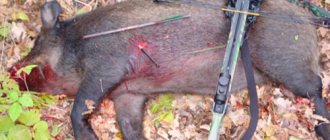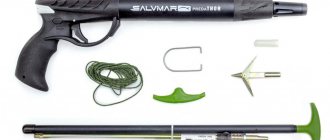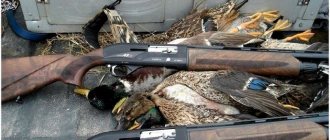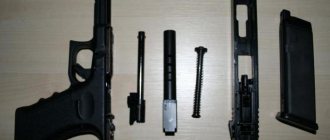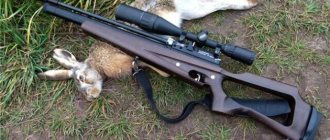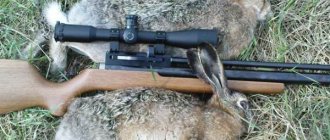A crossbow is a good gift for a person who loves sports, hunting and shooting at a shooting range. It should not be confused with a bow; compared to it, a crossbow has a number of advantages. It is more accurate, shoots further and stronger. In this article, we will look at the subtypes of crossbows and the main details that you should pay attention to first. After reading the article, you will learn more about crossbows and understand how to choose a crossbow.
When thinking about how to choose a crossbow, it is worth noting that different materials are used in production, which significantly affects the quality. This is mainly high-strength plastic, carbon or metal. The choice of material for the bowstring deserves special discussion. It is important that it is not affected by the weather situation - heat, cold and humidity. The bowstring should be made using Dacron or Kevlar, then its service life cannot be affected by temperature conditions.
When choosing a crossbow, pay attention to its power. Important! In Russia it is prohibited to use crossbow models with a tension force exceeding 43 kg. They are considered throwing weapons and are subject to the law on liability for the possession, storage and use of weapons.
Distinctive features of the weapon
A distinctive feature of hunting with a crossbow is that the chances for both animals and humans are approximately the same. The hunter himself creates conditions that were typical centuries ago. It complicates the process, thus raising the prestige of hunting.
Many people are capable of killing an animal, for example, with a rifle. Accordingly, there is nothing to be particularly proud of. If you want to eat, you just need to go to the store and buy meat. And if hunting is viewed from the perspective of sport or entertainment, then you should put your firearms aside, pick up a crossbow and go into the forest in order to show your prowess.
Many people today are interested in hunting with a crossbow and its advantages. It should be noted that among the distinctive features characteristic of a crossbow, it is necessary to highlight the noiselessness of such a weapon. A shot from a gun can be heard several kilometers away. The only noise from the crossbow is a light clap, which can hardly be heard over the noise of the foliage already a hundred meters away. Quite often situations arise that even after the first shot the bird is in no hurry to fly away. Accordingly, you can recharge and repeat again.
Types of crossbows
Crossbows are divided into:
Purpose
In this classification, crossbows are divided into sporting, hunting, historical and recreational crossbows.
The most popular are hunting crossbows with a draw weight of up to 80 kilograms. But you can shoot from them only on private property, at your own peril and risk, and state hunting zones are prohibited for them.
Crossbows for “historical” models are fully consistent with medieval ones, with one exception, the bowstring for them is made of modern synthetic threads.
By class, crossbows are divided into elite and ordinary
The main difference between one and the other is in the materials. Elite crossbows are made from high-strength materials. They are intended for shooters for whom it is important to have tangible proof of their status and individuality.
By age group
In this classification, crossbows are divided into adult and children's. Manufacturers of crossbows for children take into account that a crossbow is a powerful weapon, but in the hands of a child it must be safe, both for himself and those around him. Therefore, the arrows in children's crossbows are replaced with rubber suction cups and a plastic target is included.
By design
There are two types of crossbows - rifle and pistol. Let us dwell on these subgroups in more detail, since they are of no small importance.
Crossbows of rifle design owe their name to the butt, made in the likeness of a rifle. Safe and convenient weapon. Crossbows of pistol design also owe their name to the butt. easy to use, convenient to transport, and also because it can be used to shoot not only arrows, but also other sports equipment - balls, harpoons, etc.
By design, crossbows are divided into two more types: classic and block.
What can you say about weapons?
What is required for such sports entertainment? Naturally, crossbows are for hunting. How to choose them? First of all, it should be noted that crossbows are conventionally divided into two categories - classic with recursive, curved shoulders, and block crossbows, which are equipped with a system of eccentric blocks. With the help of such blocks you can significantly simplify the charging process and speed up the acceleration of the boom. Which crossbow is better to choose: compound or recurve? Let's look at these two categories in more detail.
Compound crossbow
Block crossbows have a more complex design. This is due to the pulley system, they make cocking the bowstring easier and help make its acceleration stronger. Because of this, one drawback appears - the weight of a block crossbow is greater than a classic one. However, considerable weight is usually compensated by less sensitivity to bowstring distortions and greater power. This is why compound crossbows are usually chosen by hunting enthusiasts. One of the world's leading manufacturers of compound crossbows is the American ]Barnett[/anchor].
Shooting weapons with curved shoulders
Recurve crossbows are characterized by several main advantages. They are quite lightweight, easy to use, and also very reliable. The tension force of the shoulders exceeds 50 kilograms. Recurve crossbows are well suited for hunting both small and large animals. They are quite easy to disassemble. They are indispensable if the hike is planned to be long, as extra pounds can add a not-so-pleasant feeling.
Correct solution
A big plus for anyone who wants to buy a compound crossbow is that there is no need to obtain a license. Such products are not considered to be hunting weapons. If the force required to tension the bowstring does not exceed 43 kg, then these are considered crossbows for sports, recreation and entertainment; you can freely purchase similar ones in our online store. If the tension force is higher than this value, then the crossbow will be considered a hunting-civilian weapon, it does not yet require permission, this does not prevent you from buying and installing more powerful arms, however, tuning the crossbow remains on the conscience of the buyer and you need to use it in specially designated places such as shooting ranges, shooting ranges and shooting ranges.
Great weapon for hunting
Why is the question of how to choose crossbows for hunting relevant? In addition to the above advantages, it should be noted that this weapon is perfect for a variety of types of hunting. Modern crossbows have arms made from high-modulus composite materials. They are devoid of “fatigue”. This type of weapon can be carried in a cocked state for up to several hours. Accordingly, the hunter gets the opportunity to fire a shot instantly, even at a target that appears unexpectedly.
The only drawback of such weapons is that it is very difficult to hit a target that is moving. So, how to choose crossbows for hunting? To fully answer such a question, some basic points must be considered.
Video: Bows and Crossbows - Civilian Weapons
This question is from the series “will a whale take an elephant?” appears with enviable regularity in search queries. It looks like it's time to more or less decide on the answer.
In order to immediately get over the pain and close the quantitative segment of the problem, I present the average indicators of “power”, but in fact - the energy and speed of projectiles (“”) of typical representatives of hunting bows and crossbows, as well as air rifles, spring-piston (SPP) and with preliminary pumped (PCP).
But first, oddly enough, data on firearms. They will be useful to us too.
| Weapon | Projectile weight (g) | Speed m/s | Energy (J) |
| Pistol (9x18) | 6 | 315 | 300 |
| Smoothbore gun (12x70) | 33 | 450 | 3350 |
| Carbine 7.62x54 | 12 | 770 | 3500 |
| Carbine 9.3x64 | 17 | 750 | 4800 |
So, let's go. Let me emphasize that we are considering standard products in their original (not weakened for Russia or Ukraine) design, without additional “overclocking”. But they all meet real hunting requirements. Only the objects of hunting are different, in weight - a thousand times.
Let's start with pneumatics.
| Weapon | Projectile weight (g) | Speed m/s | Energy (J) |
| Air rifle PPP “magnum”* 4.5 mm | 0,68 | 240 | 20 |
| Air rifle PPP “supermagnum”* 4.5 mm | 0,68 | 310 | 33 |
| PCP 4.5mm Air Rifle | 1 | 300 | 45 |
| PCP 12.7mm Air Rifle | 18 | 220 | 430 |
And one more thing: do not trust advertising.
All manufacturers and sellers indicate attractive speeds in the performance characteristics of their spring-piston rifles: “magnum” (18-25 joules) - 305 m/s, “supermagnum” - 360-380 m/s.
Reality looks completely different:
- for “magnum” (approx. 20 joules): “half a gram” (0.55 g) - up to 280 m/s, “heavy” (0.68 g) - 240 m/s. "Hatsans" (25 J) - up to 300 m/s with light bullets and 270 with heavy ones.
- for “supermagnum”: (29-33 joules): “heavy” (0.68 g) - 290-310 m/s.
Light bullets cannot be used with “supermagnums” - the result is an analogue of a destructive blank shot. Details in the articles "" and "".
Now it's the turn of bows and crossbows
| Weapon | Projectile weight (g) | Speed m/s | Energy (J) |
| Recurve bow 70 lbs | 23 | 75 | 65 |
| Compound bow 70 lbs | 23 | 106 | 130 |
| Recurve crossbow 225 lbs* | 25 | 100 | 125 |
| Compound crossbow 185 lbs* | 25 | 115 | 165 |
Well, we have answered the question “who is more powerful?” Are you satisfied? So I don’t!
In fact, all those asking him are not interested in bare numbers, but in the practical application of these types of weapons, that is, their lethality.
But it is radically different for arrow throwers and rifles.
Again, let's start with pneumatics. There is no fundamental difference with a firearm; the main task is to transfer the maximum amount of energy to the target, causing lethal damage to internal organs. To do this, it is extremely desirable to avoid a through wound, in which the bullet takes away part of this energy. But here lies the fundamental difference between the military and hunting approaches.
In the first case, the principles of humane methods of warfare have been in effect for a hundred years, in particular, prohibiting the use of expansive (explosive) bullets, and through wounds, on the contrary, are welcomed. Roughly speaking, the enemy must be given a chance. And to be completely honest, the costs of transporting, treating, nursing and paying a wounded person are much higher than burying a dead person in the field. Moreover, a lot of the enemy’s people are distracted from direct combat operations - you can’t abandon a comrade. This is the ugly homespun truth.
When hunting, the principle is exactly the opposite. There is also a kind of “humaneness” here: since the “infirmary-medal-disability benefit” is not given to the beast, it must be obtained quickly, if possible, avoiding unnecessary suffering. Hence the use of various expansive ammunition, where the bullet in the body begins to open up like a “flower” or disintegrate into segments. These fly worse than usual.
The photo shows a pneumatic expansive bullet.
The selection of ammunition is an eternal compromise between speed, flatness and stopping power.
This is especially true for pneumatics. She does not have thousands of joules of energy in reserve that, due to hydrodynamic impact, can create temporary pulsating cavities in her body, characteristic of firearms (pictured).
Therefore, special precision and accuracy are required from the shooter.
Before us is the “supermagnum” “,” which produces 310 m/s in a 4.5 mm caliber and 33 J of energy with a 0.68 gram bullet and is by far the most powerful serial spring-piston rifle.
Most biological targets designed for this power will be freely pierced with a lightweight, high-velocity pellet. The energy remaining in the flesh, especially when hit “locally”, is quite enough to catch a hazel grouse pigeon, even a rabbit (see “ ” and “ “). Just, for God’s sake, do not confuse hazel grouse with black grouse and especially wood grouse - these are completely different birds, the tiny musk deer and the huge elk are also from the same deer family.
However, from an ordinary 20-joule “magnum” - with an accurate hit to the head.
The point here is this. When hunting, game is often killed by a single “golden” pellet/buckshot. Sometimes the entrance hole cannot be found immediately, as if the animal died of a heart attack.
Bullets of 4.5 mm caliber in terms of weight and size characteristics approximately correspond to fractions from “00” to “000” (hare, fox, wood grouse). And if, at the end of the barrel, a single pellet is noticeably superior in speed/energy to a pellet, then with increasing distance this difference first levels out and then changes sign (in the “supermagnum”, of course, earlier). This is the advantage of rifled weapons, which includes almost all long-barreled pneumatics.
Different rifle, different approach. The Career Dragon Slayer is one of the most powerful pre-pumped (PCP) air rifles available.
A heavy 18-gram 50-caliber bullet (12.7 mm) develops only 220 m/s, but produces 430 joules. And all of them will go to the deer carcass, which is what such weapons and ammunition are actually intended for.
Such rifles also have disadvantages. In addition to the exorbitant price, these are short firing distances, low projectile speed and the associated ricochets of a round-headed bullet from any branch. But, again, if it hits “locally”, it has an acceptable stopping effect. Although when it comes to large animals, everything is not so rosy - see the final section of the article ““. But since August 2016, such weapons can also be used to throw heavy hunting crossbow bolts (see “ “).
Ammunition and its practical use are also discussed in sufficient detail in the articles “” and ““.
Features of the use of bows and crossbows
It is precisely the stopping effect that all arrow throwers, bows, and crossbows lack. In terms of energy, they are tens of times weaker than shotguns and rifles (see tables), and are used mainly for animal hunting. In historical terms, there were, of course, exceptions to the monstrous tension force cocked with the help of a gate and a partner. They fired heavy steel “bolts” and were intended to knock out armored horsemen, preferably piercing knightly armor. In a word, these are, rather, not small arms, but peculiar medieval anti-tank guns.
In combat and hunting, completely different devices were used en masse, and their damaging factors also looked different.
This is exactly how crossbow and archery hunting takes place now, where a mighty animal with a high pain threshold and level of “vital force” simply loses it, pierced right through with an arrow with razor-sharp tip blades.
This happens due to the cutting of blood vessels, causing rapid blood loss. Clearly, we are not talking about a sniper shot into an artery. Apart from the heart and liver, which are also very difficult to hit with a arrow thrower, the main target is the lungs. The organ is quite solid, paired, that is, located on both sides of the body, and also densely penetrated by a network of blood vessels.
With the blood, life gradually flows out. I have a suspicion that often the animal does not even understand what is happening to it, but simply runs away to the side and, feeling a sudden surge of drowsiness, lies down to rest.
This is if you don’t scare him, jumping out of cover with a triumphant cry. Then the animal “on adrenaline” is able to get away from the hunter for hundreds of meters, often to no avail.
For this type of hunting you will need a strong (at least 60 Lbs) compound bow
or a crossbow with hunting shoulders:
– recursive – from 200 lbs;
- block - from 165 lbs (some unique designs provide excellent performance even at 140 lbs).
With a bow, everything is very, very difficult, since shooting and hitting with it is much more difficult than with a crossbow. Even more or less easy-to-learn “blockers” have a lot of nuances, and not everyone can devote the necessary time to regular training, which is indispensable here. And only a few will be able to stretch a 70-pound hunting “recurve” without refined technique and the corresponding muscle groups developed by special exercises to a normal attachment.
The technique of shooting from a crossbow is almost no different from a rifle-rifle, adjusted for short shooting distances. In addition, there are a number of purely hunting devices that do not even have a bowstring as a class, but the speed indicators are unattainable for conventional crossbows, and visually they are more reminiscent of a modern assault rifle (see ““).
But there are also types of hunting where the arrow does not “sew”, but, like a bullet, transfers its energy to the game - for example, “feather” hunting. For these purposes, completely different tips, so-called “shockers,” are used.
Firstly, even a non-hunting bow is strong enough to do this. In any case, a regular one (pictured) will do.
And secondly, such spreading tips prevent the long flight of the arrow, and they also get tangled in branches and grass, and it is relatively easy to find it, even if it misses.
Subjective indicators of the power of bows, crossbows and pneumatics
If we are not talking about hunting, but about entertaining “shooting games” for a bet, then I can say the following.
A magnum-class spring-piston rifle sews a half-inch board right through, and splits some (apparently with defects). “Supermagnum” is capable of making holes in commercial rolled metal - mind you, with soft lead bullets. “Overclocked” rifles with modified ammunition make this easy. A blank fence made of corrugated sheets is not an obstacle for such pneumatics - keep this in mind.
A standard 95 lbs/43 kgf compound crossbow at a 30-meter distance usually splits already one-inch boards. Moreover, the arrow also stabs not too thick (up to 10 centimeters) trees, although it gets stuck in a split. She doesn’t notice corrugated sheeting and similar materials at all, only losing her plumage. In its hunting version, fired from a crossbow with original arms of 80-100 kgf, it destroys everything that gets in its way, including the rather frail scapula of a large animal.
A 40-pound recurve bow is much more loyal to various obstacles, mainly arrows. But a legal “blocker” with 60 Lbs hits not much worse than a forbidden powerful hunting crossbow.
Please consider all of the above information when choosing a shooting location (see “Where to shoot with a bow and crossbow?”). Health, including mental and financial health, is more valuable than entertainment.
In conclusion, I suggest you watch a wonderful video on the topic “arrow versus bullet” that we discussed today. True, we are not talking about pneumatics here, but some of its models are quite comparable in energy (“more powerful”) to the tested firearms. And, as we have already seen, the “air” is not fundamentally different from it.
And shooting at a shooting range. It should not be confused with a bow; compared to it, a crossbow has a number of advantages. It is more accurate, shoots and is stronger. In this article, we will look at the subtypes of crossbows and the main details that you should pay attention to first. After reading the article, you will learn more about crossbows and understand how to choose a crossbow.
When thinking about how to choose a crossbow, it is worth noting that different materials are used in production, which significantly affects the quality. This is mainly high-strength plastic, carbon or metal. The choice of material for the bowstring deserves special discussion. It is important that it is not affected by the weather situation - heat, cold and humidity. The bowstring should be made using Dacron or Kevlar, then its service life cannot be affected by temperature conditions.
When choosing a crossbow, pay attention to its power. Important!
In Russia it is prohibited to use crossbow models with a tension force exceeding 43 kg. They are considered throwing weapons and are subject to the law on liability for the possession, storage and use of weapons.
What should the power be?
This parameter largely depends on several components.
- The strength that a spirit can develop at the maximum permissible point of the bowstring's stroke.
- The ability of the arc to bend as much as possible is the stroke of the bowstring.
There are people who want to purchase weapons with a pulling force of 200 kilograms or more. Naturally, this idea can be considered crazy. In order to confidently shoot at a large animal from a distance of 50 meters, a weapon with a tension force of 50-70 kilograms is enough. Which crossbow to choose for wild boar hunting? The tension force at the shoulders in such a situation should be slightly greater - approximately 80 kilograms. No need to run for power. If the bolt is selected well, and if you have the skills, you will get many more benefits.
Hunting with a crossbow is an exciting sport!
When hunting with a crossbow, the chances of the hunter and the animal are almost equal. The main thing here is to be able to shoot in time and hit the target, since there may not be enough time for the second shot. Hunting with a bow and crossbow first begins with studying the design of your hunting weapon and equipment. To go on a real hunt, where danger awaits, you need to learn how to shoot correctly and accurately, and for this you will have to put in a lot of effort. First you need to choose the appropriate type of crossbow, then learn how to shoot with it, having first studied the shooting technique and all the nuances. Only after you are confident in the quality of the shot and the accuracy of the hit, can you safely look into the eyes of the danger and the animal you encounter while hunting.
For many, it is not clear why hunting with a crossbow can be attractive. But if someone does not understand, then there is no need to convince him that hunting with a crossbow is better than with any other weapon. Some prefer hunting weapons, others prefer throwing knives, and still others use a bow or crossbow for hunting. It is difficult and unnecessary to understand everyone, let everyone choose the weapon for hunting that is more familiar to them, and we will look at what hunting with a crossbow is.
It is worth saying that for many, hunting with a crossbow is a hobby that gives a feeling of extreme sports, danger, and increases the level of adrenaline in the blood. A hunter with a crossbow, when meeting a victim, shows his superiority, intelligence and ingenuity. After all, if it’s quite easy to shoot a wild boar with a rifle, the same cannot be said if you hunt with a crossbow. In this case, the hunter, when meeting with the beast, equalizes the chances of success on both sides, the man himself complicates the hunt, makes it clear to the beast that he will not emerge victorious from a dangerous duel.
Hunting with a crossbow is always carried out without unnecessary noise, which attracts many hunters. If a shot from a gun can be heard within a radius of several kilometers, while all the animals manage to hide in holes, then a crossbow arrow flies silently, even an animal that is located a few meters from the hunter will not know about the shot. In some cases, the shot is so silent that the hunter has time to reload the weapon, make adjustments and repeat the shot
photo. Hunting with a crossbow and camouflage
Why hunting with a crossbow is better than hunting with a bow
In addition to the fact that hunting with a crossbow is silent, it has many more advantages that are difficult to dispute.
The first advantage of this weapon is its purchase. If to purchase a firearm you must have a license and other permits, then you can buy a crossbow without paperwork. True, you still won’t be able to go hunting with him without a special hunting license; if you do this, and even shoot the animal, you may be arrested for poaching.
The advantage of crossbows is their power, which is sometimes simply amazing. The arrow that an archer shoots flies at very high speed, piercing almost everything in its path. If you want to see if crossbow hunting appeals to you, you don't have to buy a very expensive crossbow right away. There are many options available today to help you decide whether you want to continue hunting with a crossbow or whether you're better off using a firearm.
The best crossbow for hunting, or which crossbow is better to choose
On store shelves there are various hunting crossbows that attract with their design, construction and power. You can view their photos on the Internet or on our portal. Basically, crossbows for hunting are of the following types:
- recursive;
- blocky.
Recurve crossbows are also called classic. They attract the attention of hunters due to their light weight, which is very convenient for transportation. Model of a recurve crossbow in the photo:
In addition, their advantage is convenient use, ease of assembly and disassembly. Professional hunters and beginners can easily use such small arms.
The block type of crossbows is distinguished by its power. Such models are equipped with eccentric blocks that allow achieving high acceleration and boom speed results. Of course, unlike recurve crossbows, block models are distinguished by noticeable weight. Compound crossbow in the photo:
photo. Hunting crossbow
If you are thinking about the question of which crossbow is better, then everything will depend on what kind of animal you will hunt. Recurve models are more suitable as hunting weapons for birds or small game. If you are thinking of using them against a large animal, you will need a pulling force of more than 50 kg. That is why block-type crossbows are more suitable for hunting large animals. In addition, block crossbows can be used if you plan to hunt from an approach or ambush. For wild boar hunting, it is better to choose a block crossbow with a draw force of about 80 kg.
To hunt artiodactyls, small arms with a tension force of up to 60 kg are used, while shooting and aiming must be carried out from a distance of at least 50-60 meters. An interesting fact is that some hunters even manage to use recurve crossbows for fishing.
What are the characteristics of sighting devices?
The question often arises about what to choose for hunting: a bow or a crossbow. It should be noted that crossbows are the most convenient for the reason that in most cases they are equipped with sights.
The main feature of such devices is characterized by the ballistics of the flight of a fired bolt or arrow. This can cause quite strong changes in the position of the sight line relative to the flight line in the case of a minimal change in the distance to the animal. Modern small arms of this type have a dovetail seat. Every hunter can install whatever he likes on this nest.
It should be noted that in reality the crossbow does not need a very powerful scope. 4x optics is more than enough. It is best to use a collimator sight, which is characterized by high convenience. With its help, shooting can be done both during the day and at dusk. This type of sight is also perfect if you need to shoot quickly at targets that are in motion. Therefore, there is nothing strange in the fact that it is a collimator sight that experts recommend purchasing.
How to choose a crossbow for hunting: varieties, power, choice of materials
Hunting with a crossbow is a hobby that requires careful preparation. This is real art. Hunters never waste arrows just like that. After all, every shot can be decisive. Which crossbow to choose for hunting to achieve an accurate hit on the target?
Thanks to the crossbow, the hunter has several advantages:
- the weapon does not lose its characteristics at low temperatures;
- the speed of the arrow is so high that the animals do not have time to dodge;
- when shooting there are no loud sounds that could scare away the prey;
- hunting with a crossbow allows a person to get closer to the animal;
- weapons are inexpensive, even people with little income can purchase them.
Produced crossbows can be divided into the following types:
- classic models that have curved shoulders;
- block devices designed for hunting large game.
Advantages of classic models:
- Recurve crossbows are lightweight. They can be carried over long distances.
- The design of these models is simple and easy to maintain.
- You don't have to worry about customizing classic models. They have high accuracy. Hunting with a crossbow is an ideal option for hunting small game.
- You can replace a broken bowstring at any time. You don't have to spend a lot of time for this.
Advantages of block models:
- Block models are not as wide as classic ones.
- The trigger mechanism is more reliable because it is subject to less stress. This means that this crossbow will remain operational much longer.
- Arrows fired from a compound crossbow fly at a fairly high speed. This characteristic is important when hunting cautious prey that can instantly jump away in case of danger.
- The power of a crossbow is one of the advantages of this type of weapon.
Recursive
They are distinguished by their simplicity of design. Classic models weigh about 2 kg. If necessary, the hunter can easily replace the bowstring. It will take you only 5 minutes to completely disassemble and reassemble the weapon. The tension force of the shoulders reaches 50 kg.
Block
Block models weigh 1.5 kg more than classic ones. You can shoot in any position. The modern crossbow is more compact in size. It will cling less to branches. Therefore, with such a weapon it is more convenient to move around the forest in search of prey. A modern crossbow seems to be created for hunting large, dangerous animals. With its help you can easily kill a moose.
Pistol crossbows
The appearance of such a weapon is similar to a pistol. Pistol-type models are capable of hitting a target at medium and long distances. Suitable for throwing arrows, darts and harpoons. When firing automatically, metal balls are used.
Rifle crossbows
The weapon got its name from the resemblance of the butt of a crossbow to the butt of a rifle. This weapon has a solid body. Hunters value it for its convenience and reliability. The handguard is attached directly to the body. Hunting with a crossbow of this type will not require much effort from you.
Criterias of choice
Almost all buyers think about how to choose a crossbow for hunting. The most important characteristics of various crossbow models include the following criteria.
Power
How to choose a crossbow for hunting based on its power? To hunt small animals, an indicator of 47 kg/s will be enough. But for a roe deer such power may no longer be enough. To successfully hunt a deer, the tension force must be at least 60 kg/s.
Weight
Hunting with a crossbow should not take much effort from a person. The optimal weight of the weapon depends on your physical capabilities. Learn that heavy weapons will be much more difficult to shoot.
Select the dimensions of the model based on their specific storage conditions. Think in advance about how you will carry your weapon while hunting.
Material
Most often, the stock is made of aluminum. More expensive models are equipped with a stock made of composite materials. The butt can be either wooden or plastic.
They can be installed for both right and left hands. It all depends on the individual preferences of the person. Hunting with a crossbow requires the owner to be a professional weapon owner.
Weaver plank
It serves to fix the sight. In most modern models, this option is included in the basic package. The sight itself is equipped with illumination.
This function is one of the most important in a crossbow. In case of an accidental blank shot, the shoulders may not be able to withstand the load. There is a high probability that they will simply break. In this case, the weapon will lose its functionality.
Price
How to choose a crossbow if you want to save money? A high price does not guarantee that the selected item has high combat characteristics. The cost largely depends on the brand. However, not all hunters are willing to overpay for a big name.
The manufacturer sets the price based on many factors. These include the quality of the material and the work on the design of the butt. People are often mistaken when they see a sign that a crossbow is made in the USA. In fact, most of the production facilities of large companies have been operating in China for a long time. Some of them are located in Taiwan.
Preferred Materials
Weapon shoulders can be made from the following materials:
- steel;
- aluminum;
- laminate;
- composites.
Composite materials consist of carbon and fiberglass. For hunting, this option is considered optimal. The composite has sufficient strength. It is not subject to deformation. The material is reliable and durable.
If you are going to use a modern crossbow for hunting, then it is better to buy models with a plastic stock. They are not afraid of rain and snow.
The body can be steel or aluminum. The trigger of this weapon is made of special steel.
Be sure to hold the selected model in your hands. Sometimes seconds matter. For a quick reaction you need to have a good grip.
Sight selection
The flight path of a projectile fired from a crossbow has certain features. The position of the aiming line can deviate greatly even with a slight change in the distance to the target. To increase shooting accuracy, optical sights were developed.
Almost all modern models are equipped with a dovetail mount. It is necessary to install the sight. Are you going to hunt at night? Then you cannot do without a red dot sight. With its help you will see clearly at any time of the day. And this increases the chances of hitting the chosen target.
For daytime hunting, you can install a regular sight with 4x optics.
Ammo selection
There are carvings on the front of the crossbow arrows. It serves for the convenience of replacing different types of arrows depending on the situation. The hunting tip is equipped with 3 steel blades. You can also find collapsible tips on sale. The length of the arrow must correspond to the stroke of the bowstring.
Depending on the type of game, there are several types of hunting arrows:
- For small animals and birds, lined arrows weighing up to 25 g are intended.
- To bring down a large animal you need to use special steel bolts. Their weight reaches 40 g. The firing range is greatly influenced by the power of the crossbow.
How to use a crossbow correctly
To avoid injury and damage, follow these rules:
- Don't shoot blanks. This way you risk deforming the shoulders and bowstring of the weapon.
- The fingers of the left hand should not cross the path of the bowstring.
- Foreign objects may touch the crossbow's shoulders. You need to carefully monitor the condition of the bowstring, which may not withstand the load.
Video
From our video you will learn which arablet to choose for hunting.
ohota.guru
What projectiles are used?
Crossbows and bows for hunting differ in that they shoot with arrows (bolts). If you plan to hunt a large game, then it is best to use branded ammunition made of carbon or fiberglass. They are characterized by lightness, high strength, ideal geometry and correct “weight distribution”. Aluminum bolts are best used during target practice.
Bolts for hunting small game or birds are usually shorter and lighter. The maximum weight reaches 25 grams with a length of 30 centimeters. Fiberglass and aluminum are two materials that are ideal for these types of arrows.
You can also find harpoon arrows on sale, which are used when hunting fish. This type of sports entertainment has gained popularity in America. Arrows of this kind are distinguished by a special needle-shaped shape. It makes the bolt move easier underwater. The tip has a “tooth”. There is a small hook on the butt plate of the bolt. A nylon thread is tied to it, which, in turn, is wound on a special reel.
Shop-club Samara sniper
Crossbow hunting is sometimes more difficult than rifle hunting, but those who try it at least once will never say that this is nonsense and that buying a crossbow was a waste of money. Crossbow hunting puts you on almost equal terms with animals, unless of course we are talking about fed animals in forestry. Of course, it’s scary to go after a bear with a crossbow; you won’t have time to reload, but as I was told, not everyone will go with a gun.
The main advantage of hunting with a crossbow is its noiselessness. A rifle shot will be heard several kilometers away, and a shot from a crossbow is almost silent, its clap will quickly disappear into the air.
Which crossbow to choose for hunting?
Modern crossbows are conventionally divided into two classes: - recurve crossbows (with curved shoulders); - block crossbows are equipped with a system of eccentric blocks, which facilitate loading the crossbow and speed up the acceleration of the arrow).
Advantages of recurve crossbows: - lightness; — easy to use; — reliability; - easy to transport.
Having arms with a pulling force of more than 48 kg, recurve crossbows are suitable for hunting any small, large animal and bird. This type of crossbow is ideal for long hikes, where every kilogram counts.
Block crossbows are quite heavy, but they are good for outdoor hunting of large, often dangerous animals, when a large reserve of power and high energy are needed.
In general, crossbows are perfect for various types of hunting: both “from ambush” and “from the approach.” The only type of hunting in which a crossbow is useless is shooting at a flying target - it is extremely difficult, almost impossible, to hit.
The power of a block crossbow and a recurve crossbow depends on two parameters:
1) the force that the arc develops at the limit point of the bowstring stroke;
2) the ultimate ability of the arc to bend or the stroke (excursion) of the bowstring.
For confident shooting at a large ungulate animal at a distance of up to 50 meters, a crossbow with a tension force of 50-70 kg is sufficient. For wild boar hunting, we recommend a slightly more powerful crossbow - with a shoulder weight of about 80 kg. DON'T CHASING POWER - properly selected ammunition and good shooting skills will give you much more advantages than shoulders with monstrous power.
What ammunition is best to use for crossbow hunting?
For hunting large game, we recommend using branded arrows (bolts) made of carbon or fiberglass. They are distinguished by lightness, strength, ideal geometry and correct “weight distribution”. Sometimes there are good aluminum arrows, but they are more suitable for practice shooting.
Often, hunting arrows have a threaded insert on the front cut of the shaft. It allows you to change the tip from sporting to hunting and vice versa. A hunting tip is most often equipped with three or more steel blades, sometimes the tips are collapsible with the ability to replace individual blades.
The fletching of hunting arrows is always longer than that of sporting arrows. This is explained by the fact that the arrow must instantly stabilize in flight and take a firing position, this is especially important when shooting at a distance of up to 30m. The length of the arrow usually corresponds to the guide of the crossbow and the excursion of the bowstring - most often hunting arrows are from 40 to 50 cm long. The weight of a hunting arrow is approximately 30-35 grams.
Arrows for hunting birds and small game are usually shorter and lighter, their maximum weight is 25 grams and their length is 30 cm. Fiberglass and aluminum are ideal materials for cheap, “bird” arrows.
Harpoon arrows for hunting fish deserve special mention. The harpoon arrow has a special needle-shaped shape, which allows the arrow to move easily under water and a tip with a “tooth” in the form of a spear. On the butt plate of the arrow there is a small hook to which a nylon thread is tied; the thread itself, in turn, is wound on an inertia-free reel and attached to the crossbow.
Sights.
The main feature of any sighting device is the ballistics of the flight of the fired bolt, changes in which cause significant changes in the position of the sight line in relation to the line of departure, even with a slight change in the distance from the shot to the target. Modern crossbows always have a dovetail, on which you can install whatever your heart desires. In fact, a crossbow does not need a powerful optic greater than 4x. 4X32 or 4X24 is optimal, but it is best to use a collimator sight - it is convenient both during the day and at dusk, when you need to aim with both eyes. The collimator is also good for quick shooting at moving targets. I recommend a collimator as the optimal sighting device for crossbows.
Range for shooting a compound crossbow or recurve crossbow.
The maximum distance recommended by manufacturers and hunters is about 36 meters or 40 yards. The straight flight is about 25 meters, then a serious fall begins, about 3 - 7 cm at 5 meters. An arrow will kill an animal at 100 meters, but try to hit it with such differences. The wind affects the arrow much more than the bullet, which also entails more serious adjustments.
Where to shoot?
Killer places for crossbow shooting are not only the chest and neck, but also the stomach. For example, a wild boar, after an arrow hits the stomach area, simply sits on the ground and screams, a couple of seconds and the second, control arrow stops the torment. The most “killer” places, of course, are the neck and chest: a hunting arrow easily spreads the ribs and, even breaking one of its blades, goes deep inside and inflicts fatal wounds. When an adult deer is hit in the chest with a “60-kilogram” crossbow from a distance of about 50 meters, the arrow travels 20 centimeters inside and reaches vital organs. If the tip was fastened “tightly” and cannot be unscrewed, then it is no longer possible to remove the arrow from the victim, you can only cut it out.
How humane is hunting with a crossbow?
Firstly, a hunter with a crossbow has only one responsible shot and must clearly decide whether to shoot or not. If the distance or power of the crossbow does not allow you to confidently kill the animal, it is better not to shoot at all. A crossbowman never fires like a madman at the bushes in bursts - everything is always decided by one single arrow.
Secondly, it has long been proven that a shot from a crossbow at distances of up to 60-70 meters is more effective compared to a bullet. Unlike a bullet, an arrow does not have a shock or stopping effect; more precisely, the “stopping effect” is achieved in a different way - a crossbow or archery arrow, hitting the victim’s body, does not allow movement, paralyzes. Possessing a three-blade tip, the arrow causes serious damage and causes rapid blood loss.
There are practically no wounded animals in crossbow hunting, so hunting with a crossbow is more humane than with other types of hunting weapons.
What should you pay attention to when hunting with a crossbow?
First of all, safety precautions. This technique is exactly the same as that of firearms, only with minor additions. The most important thing is that while shooting, it is important to vigilantly watch the fingers of your left hand - they should not fall on the line of movement of the bowstring - we don’t have many fingers to spread them out. It is necessary to carefully monitor the shoulders of the crossbow so that during the shot the shoulders do not hit branches or foreign objects. It is also necessary to monitor the condition of the bowstring - it should not have any visible damage or tears that could cause the bowstring to rupture during the shot. Blank shots should not be allowed - they can damage the shoulders and bowstring. Otherwise, the rules for handling a crossbow are based on the same laws of reason and rules of conduct for hunting.
Shoot legally
Hunting using this type of weapon (block and recurve crossbows with a tension force of more than 48 kg) is permitted and very popular in some CIS countries, Europe, America and third world countries. In accordance with the legislation of the Russian Federation, today, a crossbow with a shoulder tension force of no more than 43 kg is classified as a throwing weapon with acceptable technical characteristics. Based on this, we can assume that crossbows with a draw weight of less than 43 kg. do not relate to military throwing weapons, but are equated to sports equipment that does not require any special permission for acquisition and use.
Be sure to have a copy of the certificate with you confirming that you do not have a weapon. This certificate is usually included with the crossbow when it is sold.
.
Optimal distance for shots
During hunting, it is necessary to use a weapon of such power that conventionally direct shooting at the chest figure is not less than 50 meters. The flight path of a crossbow arrow has some peculiarities, and it is very difficult to calculate over long distances. Therefore, it is advisable to fire at targets that are at a distance of 50-60 meters. The issue of shooting accuracy should not worry. Any modern crossbow is several times superior to smoothbore weapons in this parameter.
Where should you aim?
The most lethal places are the chest, neck and abdomen. A hunting arrow can quite easily spread the ribs apart. And even if one of the blades breaks, the bolt will penetrate as deep as necessary to inflict a fatal wound. If the tip is firmly attached, it will no longer be possible to remove the bolt from the animal. It will have to be cut out.
What should you pay attention to?
When hunting with a crossbow, the first thing you need to think about is safety. It is almost the same as when using firearms. Except for a few additions. During shooting, you must constantly monitor your left hand, or rather its fingers. They should not be in the line of movement of the bowstring. Otherwise, they will simply be cut off.
You need to carefully monitor the shoulders of the weapon. When firing, they should not touch branches or any foreign objects. It is necessary to carefully monitor the condition in which the bowstring is located. There should be no damage or tears. Blank shots can cause damage to the shoulders and bowstring. Therefore, they should not be allowed under any circumstances.
Arrow selection
Crossbow arrows are available in lengths of 14, 16, 18, 20 and 22 inches. The recommended size is indicated in the operating instructions. It is acceptable to use a longer one. In any case, the arrow shaft should fit snugly against the guide along its entire length. Now they are made from the following materials:
- carbon - carbon fiber plus a binder;
- aluminum – hollow with replaceable tips;
- fiberglass (fiberglass).
Wherein:
- For hunting, heavy arrows are used, which fly slower but have greater penetrating power. These are full-bodied carbon (the heaviest) and aluminum, suitable for hunting small game.
- For sports competitions, aluminum and, to a lesser extent, fiberglass are used, which, due to their low weight, are highly susceptible to wind.
- Fiberglass, the lightest, is used for recreational shooting. In most cases, their use on serious crossbows is undesirable, since it is equivalent to a blank shot, leading to damage to the weapon.
Hunting arrows for ungulates have a massive metal tip, often with several blades. For better stabilization, their feathers are longer. For feather and small game hunting, a simple point is sufficient.
Arrows for compound crossbows have a moon nock at the end. They have two-color plumage - the stabilizer, which differs in color, is installed in the groove of the guide.
This video provides an overview of different crossbow arrows:
The review will be useful to all those who are interested in throwing weapons.
The bow is the only known type of weapon that has remained virtually unchanged throughout the history of its existence, which is no less than about 10,000 years.
The modern weapons industry offers many bow models, which can be divided into the following categories:
- block,
- children's,
- classic,
- sports,
- traditional.
Compound bows are most often used for sports and hunting.
The main differences between a traditional and compound bow are:
- The most obvious distinguishing feature is the design. Without exception, all traditional bows are an arch with a bowstring. Compound bows are equipped with special mechanisms located on the bow's limbs. Thanks to these mechanisms, less effort is applied during aiming (compared to a traditional bow). By and large, in this case the tension of the bowstring is practically not felt.
- Because bow designs are different, so is the shooting technique used.
- There is still no consensus on the power of these categories of weapons, since everything here depends not only on the characteristics of the weapon and arrows, but also on the skill of the shooter, as well as on weather factors.
- The compound bow has a very compact design, which greatly facilitates its storage and transportation. In addition, unlike a traditional bow, a compound bow can be stored without removing the string. At the same time, traditional onions need rest and special care.
- Alas, the compound bow is a type of weapon that can be expanded endlessly. Be prepared for additional costs when purchasing the base model. For reference: fully equipped models are marked with the abbreviation PKG (package - packed, completed).
Important: use of onions, incl. blocky, in hunting - this is already aerobatics! Bowhunting requires that you have a long history of hunting and a good understanding of bows! If not, then you should pay attention to filling gaps in knowledge.
It is better to fill in the missing information about weapons in an archery club or section. If visiting a specialized club is not available to you, study the teaching materials of Mikhail Khuskivadze, a coach who has trained many talented archers.
Do not forget that a bow is, first of all, a weapon that must be used in compliance with all safety rules.
